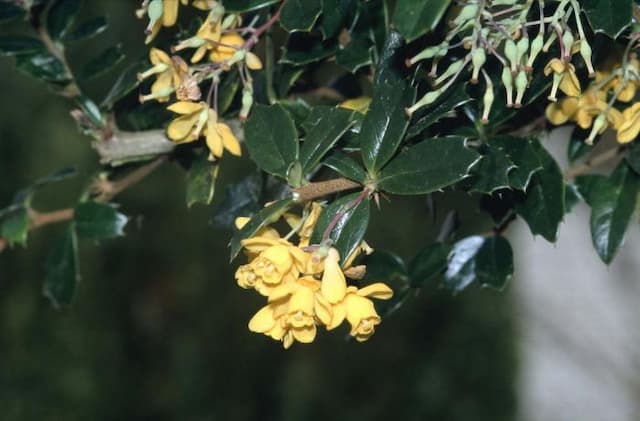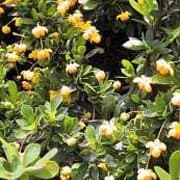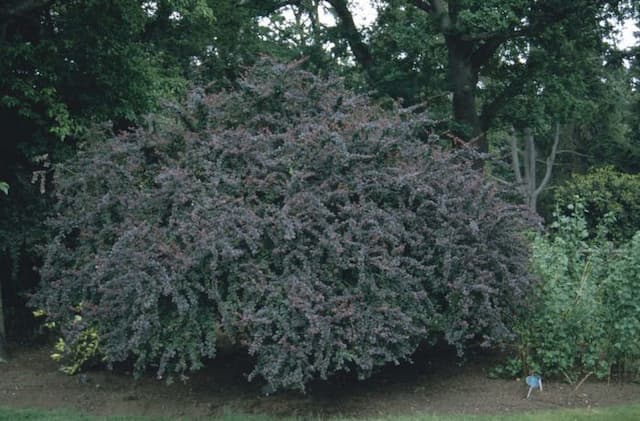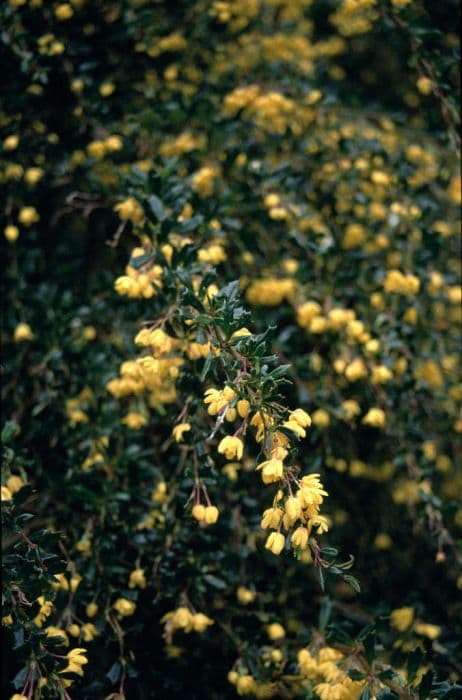Barberry 'Apricot Queen' Berberis × lologensis 'Apricot Queen'

ABOUT
'Apricot Queen' is a spiny evergreen medium-sized shrub, open and rather arching in habit. Leaves oblong, dark green. Flowers abundant, bright orange, in drooping panicles
About this plant
 Names
NamesFamily
Berberidaceae
Synonyms
Apricot Queen Barberry
Common names
Berberis × lologensis 'Apricot Queen'
 Characteristics
CharacteristicsLife cycle
Perennials
Foliage type
Deciduous
Color of leaves
Varies
Flower color
Yellow
Height
5 feet (1.52 meters)
Spread
4 feet (1.22 meters)
Plant type
Shrub
Hardiness zones
7
Native area
Hybrid
Benefits
 General Benefits
General Benefits- Attractive Foliage: It has evergreen leaves that provide year-round visual interest.
- Floral Display: 'Apricot Queen' produces striking apricot-orange flowers that can enhance the beauty of any garden.
- Drought Tolerance: Once established, it is relatively drought-resistant, making it suitable for xeriscaping.
- Low Maintenance: It requires minimal care once it is established, making it ideal for gardeners who prefer low-maintenance plants.
- Habitat for Wildlife: The shrub offers shelter and food for birds and other wildlife.
- Dense Growth Habit: Its thick foliage can be used for hedging or privacy screens.
- Adaptability: It is adaptable to a range of soil types, provided they are well-draining.
- Tolerance of Conditions: It can tolerate a variety of conditions, including urban pollution and some shade.
 Medical Properties
Medical PropertiesThis plant is not used for medical purposes.
 Air-purifying Qualities
Air-purifying QualitiesThis plant is not specifically known for air purifying qualities.
 Other Uses
Other Uses- Bonsai Creation: Berberis × lologensis 'Apricot Queen', known as Apricot Queen, can be trained as a bonsai, offering a unique challenge due to its spiny branches and colorful foliage.
- Wildlife Habitat: This shrub can provide shelter and protection for birds and small mammals in the garden, thanks to its dense, thorny branches.
- Photography Subject: The attractive qualities of the Apricot Queen make it an excellent subject for garden photographers, especially during blooming.
- Natural Fencing: The thorny nature of the Apricot Queen makes it an effective natural barrier for property lines or to deter uninvited animals.
- Dye Production: The bark and roots, if harvested, can be used to produce yellow dye for textiles or crafts.
- Soil Erosion Control: The robust root system of this plant can help stabilize slopes and prevent soil erosion in your garden or landscape.
- Garden Sculpture: Trim and shape this versatile shrub to create living sculptures or topiary in formal gardens.
- Educational Tool: Apricot Queen is an excellent specimen to use in educational settings for teaching about plant adaptation and defense mechanisms due to its spines and resilience.
- Hedge Contrast: Plant Apricot Queen in combination with plants of differing textures and colors for a striking hedge with vivid contrast.
- Culinary Garnish: Although not for consumption, sprigs of the non-toxic foliage can be used as a decorative garnish for culinary presentations.
Interesting Facts
 Feng Shui
Feng ShuiThe Barberry 'Apricot Queen' is not used in Feng Shui practice.
 Zodiac Sign Compitability
Zodiac Sign CompitabilityThe Barberry 'Apricot Queen' is not used in astrology practice.
 Plant Symbolism
Plant Symbolism- Protection: The genus Berberis, commonly known as Barberry, is often associated with protection due to its thorny branches, which can serve as a natural barrier against unwanted intruders.
- Purity: The bright colors of the 'Apricot Queen' variety, particularly the apricot hues, can be symbolic of cleanliness and innocence.
- Resourcefulness: Barberries are known for their hardiness and ability to grow in challenging conditions, which can symbolize an individual's ability to thrive despite obstacles.
 Water
WaterWater the Apricot Queen Barberry deeply once a week during its growing season, ensuring the soil is thoroughly moistened. During periods of drought or extreme heat, increase the frequency to twice a week. In cooler months or when rainfall is sufficient, you may reduce watering. Each watering session should consist of about 1 to 2 gallons per plant, depending on the size and age. Ensure the plant has well-draining soil to prevent waterlogging.
 Light
LightApricot Queen Barberry thrives best in full sun to partial shade. Plant it in a location where it can receive at least 6 hours of direct sunlight daily. An ideal spot can be a sunny border or an area that has sun for most of the day with some afternoon shade.
 Temperature
TemperatureApricot Queen Barberry is hardy and can generally tolerate a range of temperatures. It can withstand a minimum temperature of around 0 degrees Fahrenheit and can survive up to temperatures of about 100 degrees Fahrenheit. The ideal temperature range for this plant is between 60 to 75 degrees Fahrenheit for optimal growth.
 Pruning
PruningPrune the Apricot Queen Barberry in late winter or early spring before new growth begins. Pruning is done to maintain shape, remove dead or diseased branches, and encourage new growth. Prune up to one-third of the oldest stems to ground level yearly, and trim back overgrowth as needed. The best time for pruning is when the plant is dormant.
 Cleaning
CleaningAs needed
 Soil
SoilFor Barberry 'Apricot Queen', a well-draining soil mix is ideal, consisting of loam, sand, and a portion of organic compost to provide a balanced structure. This Barberry thrives in a soil pH range of 6.0 to 7.5, accommodating slightly acidic to neutral conditions.
 Repotting
RepottingBarberry 'Apricot Queen' doesn't require frequent repotting and should be replanted approximately every 2-3 years, or when it has outgrown its current container or the soil has expended its nutrients.
 Humidity & Misting
Humidity & MistingBarberry 'Apricot Queen' is tolerant of a range of humidity levels but prefers moderate conditions; excessive humidity is not necessary for its health or growth.
 Suitable locations
Suitable locationsIndoor
Place in bright light, limit watering, ensure good air circulation.
Outdoor
Full sun to partial shade, well-draining soil, hardy shrub.
Hardiness zone
5-9 USDA
 Life cycle
Life cycleThe life cycle of Berberis × lologensis 'Apricot Queen', commonly known as Barberry, begins with seed germination, which is influenced by the plant's need for stratification to break dormancy. Following germination, the seedling emerges and goes through a juvenile phase, where it focuses resources on root and foliage development. As it matures, it enters the vegetative stage, marked by the growth of its distinctive spiny branches and the development of leaves. The plant then advances to the reproductive stage, producing clusters of yellow-orange flowers typically in the spring, which, after pollination, develop into small red berries. These berries are then dispersed, often by birds, allowing for seed dispersal and the potential for new plant growth in suitable locations. Throughout its life cycle, the Barberry may also undergo vegetative propagation through cuttings and layering, supplementing its ability to reproduce and maintain its population.
 Propogation
PropogationPropogation time
Spring-Early Summer
The most popular method of propagating Berberis × lologensis 'Apricot Queen' is by semi-hardwood cuttings. This process typically takes place in late summer after the current year's growth has started to mature and harden off a bit but still retains some flexibility. To propagate by this method, healthy non-flowering shoots are selected and cut into lengths of about 4 to 6 inches (10 to 15 centimeters), making sure that each cutting has at least two sets of leaves. The bottom set of leaves is removed, and the cut end is dipped into rooting hormone to encourage root development. The cutting is then placed in a well-draining potting mix and kept in a humid environment with indirect light until roots have formed, which can take several weeks.









